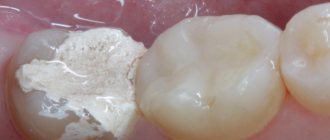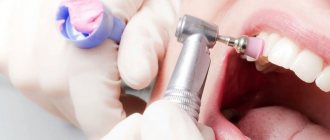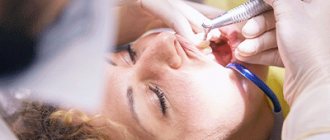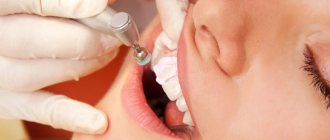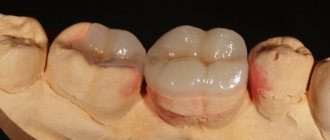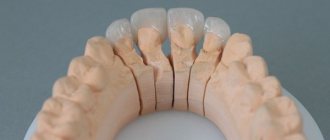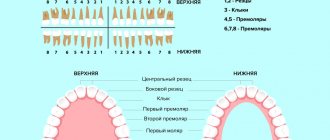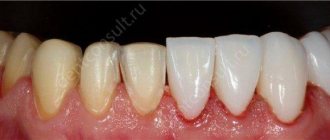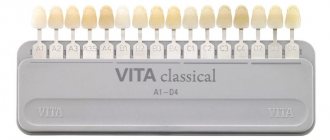03.02.2018
Caries is one of the most common dental diseases encountered in dentistry, and every person has encountered this problem at least once in their life. Naturally, there are people who have naturally healthy and strong teeth that do not require dental care. But every year there are fewer and fewer such people, and the reason for this is poor oral hygiene, bad habits, injuries and damage to teeth, and poor nutrition. Therefore, experts recommend that everyone go to the dentist 1-2 times a year, which will preserve the enamel and restore it at the initial stage of destruction.
Methods for treating caries
Dental treatment can be carried out in several ways:
- with preparation – the tooth cavity is cleared of affected areas;
- without preparation – no drill is used for treatment.
Dental treatment that does not involve preparation is an invasive and conservative method, suitable for the initial form of the disease.
Preparation is carried out in several stages:
- The oral cavity is prepared for the procedure; in some cases, teeth cleaning and removal of tartar or plaque are required.
- Depending on the complexity of the work, the specialist may use local anesthesia; in rare cases, general anesthesia is used.
- Next, the doctor begins to prepare the cavity formed by the carious process, the damaged tissue is removed, then the cavity is treated with special means. Such measures are necessary to prevent the growth of microbes, leading to the loss of the filling.
- A cavity is formed to hold the filling; for this, the dentist must give it a certain shape, which will prevent the filling compound from falling out. But most filling agents do not require such manipulations, since composites are able to chemically contact the tooth cavity.
- Isolation may require a special gasket, which is especially important in the treatment of deep caries, which helps protect the nerve from inflammation and microbes. The spacer prevents the composites from irritating the nerve of the tooth.
- Next, the filling composition is applied. To begin with, the dentist selects a shade, after which he isolates the diseased tooth with cotton swabs from other parts of the oral cavity and applies the material in layers.
Upon completion of the filling, the tooth is processed (polished and grinded), which not only makes it look natural, but also prevents tooth injury, discomfort and pain.
What types of light-curing composites are there?
Light-curing composites vary in structure and can be dense and “flowable”. There are many types of photopolymer fillings for teeth, but each of them necessarily contains three components: a polymer organic matrix, an inorganic filler and silane (a link between the organic and inorganic elements of the filling material).
Modern methods of caries treatment
Treatment of caries, dentistry offers more modern methods, subject to the initial and middle stages of the disease. They help stop the process of tooth decay and also help eliminate the cause.
The difference between modern methods of dental treatment is that the affected areas are removed without affecting healthy ones. In addition, the technologies do not include the use of boron; for this purpose, other methods of influencing areas affected by caries are used. The most popular methods are ozone, air-abrasive, infiltration and laser treatments. Such methods help not only to get rid of the disease, but also to prevent its occurrence.
If the patient has a deep stage of destruction, then treatment includes special modes of cleaning the tooth cavity with the application of a gasket under the filling material.
If it is possible to preserve the nerve, the specialist takes measures to prevent the recurrence of caries. These actions include:
- Taking into account the anatomical structure of the tooth, it is prepared with a bur.
- In order to prevent opening of the pulp chamber, the treatment of the carious cavity occurs with alternating low and high speeds of the tips.
- Caries detectors are used to identify carious areas.
- To protect the tooth from overheating, air-water cooling is used.
- Spacers are used to isolate the nerve of the tooth.
Treatment of caries involves more than one visit to the dentist, which will allow you to control the process of exposure to medications.
Sandwich technique
To achieve the most durable result when filling, several types of material are used at once, highlighting the positive aspects of each. Sandwich technology has a similar technique, it helps eliminate the disadvantages of many filling materials, such as bioincompatibility, shrinkage or deformation, for this purpose glass ionomer cements, as well as composites, amalgams and compomers are added to the filling material.
The application of gaskets made from these filling materials occurs in the following ways:
- open: the gasket covers one wall, there is contact with the oral environment;
- closed: there is no contact between the oral fluid and the edges of the cavity with the lining.
This filling technique allows:
- get rid of subgingival and cervical defects, in particular with carious destruction of the tooth root;
- stop the process of microbial proliferation;
- achieve naturalness due to the natural color of the filling;
- reduce shrinkage of filling material;
- The development of secondary caries is prevented due to the therapeutic effect of the lining.
Air abrasive method
The method is based on treating the damaged area with a sandblaster, which is used for professional cleaning of the oral cavity. During the procedure, mechanical treatment of teeth occurs by knocking out tissues destroyed by caries with a stream of air containing various impurities. Quartz sand was previously used as an admixture; later it was replaced with aluminum oxide, which does not change the color of the enamel and does not have a toxic effect. This method allows you to remove carious tissue without affecting healthy tissue. After such treatment, the risk of recurrent caries development is eliminated. The procedure is performed without anesthesia, is safe and painless, since there is no heating or vibration effect on the tooth. Air supply occurs in pulses of 6-10 seconds.
The disadvantage of the air-abrasive method is that it increases tooth sensitivity after the procedure; it is also not suitable for treating carious plaque in hard-to-reach places.
Infiltration
This method allows for dental treatment without the use of a drill. Indicated for caries caused by wearing braces or for removing carious lesions at the initial stage. A gel substance is applied to the affected surface, which can split part of the enamel. The tooth is dried with a stream of air and ethyl alcohol, after which the dentist treats it with a polymer resin.
One of the advantages of infiltration is that the procedure lasts no more than 20 minutes and there is no pain. It is worth noting that this method is only applicable to areas between the teeth and on the smooth surface of the teeth. A well-performed procedure will prevent the development of caries for many years to come.
Sandwich technique using SDR™ in the restoration of the chewing group of teeth
It is no secret that one of the main indicators of a dentist’s work is the absence of complications after treatment and long-term positive results. However, when restoring teeth in the chewing group, ergonomics of work is also of considerable importance, since it is during the restoration of chewing teeth that, due to the volume of work, a large amount of time is spent.
There are many restoration techniques using composite materials. And all these methods of restoration of chewing teeth were created with the aim of minimizing the stress of polymerization shrinkage and the complications arising from it. Let's look at everything in order.
Restoration techniques:
• Bertolotti directional shrinkage technique: two-thirds of the cavity volume is filled with a chemical-curing composite, and the rest with photopolymer. The fact is that in chemical composites, shrinkage is directed towards high temperatures - towards the tooth pulp and gum area. This technique is outdated and is practically not used today. • Directional polymerization technique. The shrinkage of photopolymers is directed towards the light source, therefore, to prevent the composite from being separated from the walls of the cavity, light curing of each portion of the composite, the thickness of which should not exceed 2 mm, is carried out through the preserved tooth structures. It is also necessary to additionally irradiate contact surfaces if they are subject to restoration. • U-shaped material application technique. Designed for three-point fixation of the composite and prevention of tightening of the tooth cusps. Only relevant in very small cavities. • Horizontal layer technique. The composite is introduced into the cavity in horizontal layers no more than 4 mm thick parallel to the bottom of the cavity. Relevant only for packable composites. • Layered restoration technique. It has several goals: to prevent nanoleakage after adhesive treatment of tooth tissue, to minimize shrinkage, to fill uneven surfaces of the prepared cavity and to improve the adaptation of subsequent portions of the composite to the tooth tissue. The cavity is filled to the dentinal-enamel border with a liquid-flowing photopolymer less than 1 mm thick, then the volume of the cavity is restored with a microhybrid or packable composite. • Cbc-technique (composite bonded compomer) - combined use of a compomer and a composite. Not currently relevant. • Sandwich technique using glass ionomer cements: the volume of tooth dentin is restored with classic, double or triple hardening GIC; occlusal surface and contact point area - microhybrid or packable composite.
The most common of these techniques are the layer restoration technique and the open and closed sandwich technique. Each of them is imperfect; Of course, it is difficult to find anything absolutely perfect in dentistry, but it is necessary to strive for it. That is why new developments appear, technologies are improved, etc. All these efforts are aimed, on the one hand, at eliminating the shortcomings of previous versions and making the doctor’s work easier, and on the other, at curing the patient.
I would like to dwell in more detail on the disadvantages of using sandwich technology using GIC. On the one hand: chemical connection with tooth tissues and the release of fluoride, the proximity of the coefficient of thermal expansion of the material to the coefficient of thermal expansion of hard dental tissues, the absence of the need for absolute isolation of the surgical field; on the other hand, there are a lot of shortcomings. First of all, these are low rates of chemical adhesion to hard tissues (2-8 MPa for chemical GIC and 8-12 for hybrid ones). Violation of the structure of the glass ionomer during conditioning, and this must be carried out if the GIC is covered with a photopolymer. High risk of GIC detachment from the bottom of the cavity during polymerization of the surface layer of the composite. Long polymerization time of the chemical glass ionomer. GIC solubility under the influence of oral fluid, short service life and unsatisfactory aesthetics, fragility, difficulty in polishing. The fact is that the hardening of classical GIC occurs according to the type of ion exchange reaction: hydrogen ions present in an aqueous solution of polycarboxylic acids are exchanged with calcium and aluminum ions of the glass included in the GIC powder, i.e. these ions bind the hydroxyl groups of polycarboxylic acids, and a GIC matrix is formed, in which unreacted glass particles are located. In the initial stage of hardening, calcium polyacrylate chains are formed (setting reaction takes up to several minutes), but these chains can dissolve in water, so the GIC filling must be protected from moisture during complete hardening. Then aluminum ions react, imparting strength to the structure due to the transverse contraction of polyacrylate chains, and a spatial structure is formed. It is at this stage that the final formation of the cement matrix occurs. Completion of this phase occurs after 2-3 weeks for classical GICs, and for hybrid ones - in 40 seconds. The final structure is glass particles surrounded by silica gel and arranged in a matrix of cross-linked polycarboxylic acid (metal polyacrylate) molecules. In hybrid GICs with a double and triple curing mechanism, the first stage of setting occurs due to photoinitiation of terminal radicals, and the second, like in classical GICs. The advantages of hybrids are the improvement of physicochemical properties, but the disadvantage is that in areas inaccessible to photoinitiation, curing occurs due to a classical chemical reaction. Triple-curing GIC has a microencapsulated redox catalyst in its composition, which complements the photoactivation reaction by self-curing the composite component of the cement, but requires a priming agent. Thus, for all glass ionomer cements, the process of complete curing does not occur in one day, which entails a number of inconveniences in the doctor’s work and the possibility of complications. • Toxicity to the pulp is due to the irritant effect of hydrogen ions for 1 day, since the curing reaction has not yet completed. • Expansion of hybrid GICs during curing by 3-4%. • The appearance of microcracks when dentin overdries. • The appearance of postoperative sensitivity, due to the hydrophilicity of GIC, the dentinal fluid tends towards the filling, causing dehydration of the dentinal tubules, and, accordingly, irritation of the odontoblast processes occurs. • The need for absolute isolation of the surgical field in the case of using hybrid GICs. • When using GIC for sandwich technology, the process of conditioning the cement surface with orthophosphoric acid leads to excessive roughness of its surface, which makes it difficult to adapt the surface layer of the composite.
Treatment of caries without filling
There are a lot of ways to treat caries, but only some of them are able to remove the affected areas without filling. Such modern methods include:
ICON technology
One of the modern methods that allows you to get rid of the initial stage of caries. Indicated for patients who have had their braces removed, the method is similar to infiltration; during the procedure, a component is used on the affected area under the influence of an ultraviolet lamp, which helps eliminate carious spots. In this case, a polymer liquid gets into the damaged areas, helping to clog the pores.
Remineralization
The procedure allows you to stop the process of tooth destruction by filling the crystal lattice of the enamel with minerals. During the procedure, the surface of the tooth is coated with a product containing phosphorus, calcium and fluoride. The dentist also prescribes tablets containing fluoride, fluoridated salt and milk.
Ozone therapy
This method of caries treatment is common in pediatric dentistry for the purpose of bactericidal effects. Ozone therapy does not involve the use of preparation, anesthesia or filling. Ozone treatment takes place without injury, noise, pain or discomfort.
During the procedure, the damaged area is treated with a drug directed from a bowl, which converts oxygen into ozone. When ozone leaves the tooth, oxygen is converted again. During the treatment, bacteria that provoke the development of caries are destroyed, while healthy tissues are not affected; due to the high resistance to ozone, tooth tissues do not change or oxidize, and there is no development of an allergic reaction. Upon completion of the procedure, the surface of the teeth is coated with a special agent to restore the mineral composition. Ozone therapy is indicated for the initial stages of caries and for patients of any age; it helps prevent tooth decay. Due to the high cost, this method is used quite rarely.
Laser treatment
Laser treatment of caries does not require cavity preparation. Since carious tissue is soft, the laser is able to disinfect and remove caries-affected areas. Laser treatment is allowed during pregnancy, childhood, and also with increased tooth sensitivity. It is worth remembering that the procedure should only be performed by a qualified dentist, since incorrect actions can lead to damage to soft tissue.
It is worth noting that treatment of caries without filling is possible only at the initial stage of development of the disease, when carious spots appear and pain occurs.
Category Caries Posted by admin
Dental sandwich plastic surgery with bone block
To understand why bone grafting is needed, you need to understand the causes of tissue deficiency. Tissue atrophy (reduction in volume) can be caused by infectious diseases, injuries, and periodontal pathologies.
A common cause of atrophy is tooth extraction. If the patient postpones a visit to the implantologist until later, the bone tissue begins to rapidly decrease (up to 25% of the previous volume per year). It is not surprising that this amount of tissue is not enough to firmly fix the implant, and the doctor has to create additional volume on his own. Bone grafting prior to implantation eliminates uneven physical load and does not allow the implant to become loose and fall out.
Our clinic’s specialists have extensive experience and dozens of proven techniques related to the restoration of bone tissue, both in width and height.
